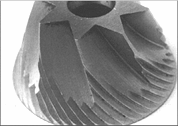Grinding Coffee
Why grind coffee at all? Couldn't you just boil the whole beans until you've extracted all the flavour from them?
Well, the answer is you can, but the resultant brew turns out very thin and bitter indeed.
The reason coffee is ground is to increase its surface area, making it easier for water to penetrate each particle and extract the oils, solids and gases which give it flavour. As a rule of thumb, the less time the water spends in contact with the coffee, the finer the grind needs to be.
If you've been paying attention so far it will be fairly obvious that for each particular brewing method and brewer there is a correct grind. What isn't obvious is how this correct grind is achieved.
Coffee grinders, as with most coffee equipment, have developed over the years, but the original coffee grinder can correctly be described as "bashing two rocks together". Of course, the rocks involved were the granite mortar and pestle that seem to be a feature of most sub-saharan African households, used for grinding spices, making pastes and for anything else that needed reducing to fine powder.
Also used were stone flour querns (a stone "wheel" with wooden handles for an axle, pushed back and forth in a stone trough.) I recently saw a Somali women preparing coffee beans in this way, after she'd roasted them over an open fire in an iron pan. This was a demonstration at a local multicultural festival.
These stone ground coffees have a consistency similar to coarse flour, very fine by coffee standards, and are only suitable for brewing in the "Turkish" style. Still, this was the original method and grind standard for 400 years or more.
In the late 18th Century a new type of grinder, the ROTARY GRINDER, first appears. Copied from flour mills, it relied on gravity to feed beans into a gap between a rotating, bladed cone and a stationary conical wall. The cone type grinder is capable of very precise grinds and high throughput at relatively low rotary speeds.
A later variation was the plate grinder, where coffee is fed between two bladed plates with an exactly set gap between them, with one rotating and one stationary plate. This generally requires higher RPM for the same output as a cone grinder. If you cut the centers out of the plates and make them hollow disks, you can feed coffee into the middle of the plates and use centrifugal force to throw the grounds out around the circumference. This design is the basis of most commercial espresso grinders. In all 3 types of grinders the bladed cutting surfaces are called "burrs", and they are generally known as burr grinders.
The thing that needs to be appreciated about a good quality burr grinder is its particle size distribution. For a given gap setting you will get a range of sizes, but the maximum and minimum sizes will fall within a definite, narrow range. A cheap burr grinder, where the gap between the burrs is not precisely maintained, will produce an uneven grind, with too much dust and a poor particle size distribution. The absolute worst variation in particle sizes comes from chopper blade type "grinders", which cut the coffee up rather than grind it. They are marginally useful for percolator, plunger and perhaps filter grinding, but even there do a fairly poor job.
Most hand grinders are of the conical burr type, and you can do anything with a good hand grinder that you can with an electric grinder…it just takes you a LOT longer, that's all. In fact solid brass hand grinders for Turkish coffee are still available today (generally made in Albania) and they produce finer than espresso grinds, far finer than most machines are capable of. Otherwise Zassenhause produce some of the finest hand grinders on the planet, but in this country they are VERY expensive.
Personally I think that a good electric burr grinder is a long term investment in quality coffee, but I would, of course! After all, I've spent thousands of dollars on good commercial grinders. If you're looking for classy home units, there is a very limited range to choose from. They are the Gaggia MDF (not MM), the Rancilio Rocky, the LUX (the one I sell) and marginally the Saeco 2002..the burrs on the Saeco are not as good, in my opinion, as the others. Outside Australia there are a number of other grinders from various makers, and a mishmash of rebadged versions of these grinders, but the only one which gets consistent praise is the Solis 166.
So what sort of grind should you be looking at for your particular brewing style? I am a great believer in checking your particular grind between your thumb and forefinger; you'll soon develop the sense of correctness and be able to tell what's wrong with a particular grind.
Grind Quick-Reference Cheat Sheet
| Brewing Style | Coarsness of Grind | Feels Like |
|---|---|---|
| Middle Eastern Coffee | Extremely Fine | Coarse Flour |
| Espresso (Except Krups) | Very Fine | Slightly Finer than Table Salt |
| Steamer, Espresso Pot, Krups | Fairly Fine | White Sugar |
| Filter Brewers | Fine | Individual Grains are Visible |
| Plungers and Syphons | Medium | Shape of Grains Just Visible |
| Percolators or Pot Brewing | Coarse | Chunky |



